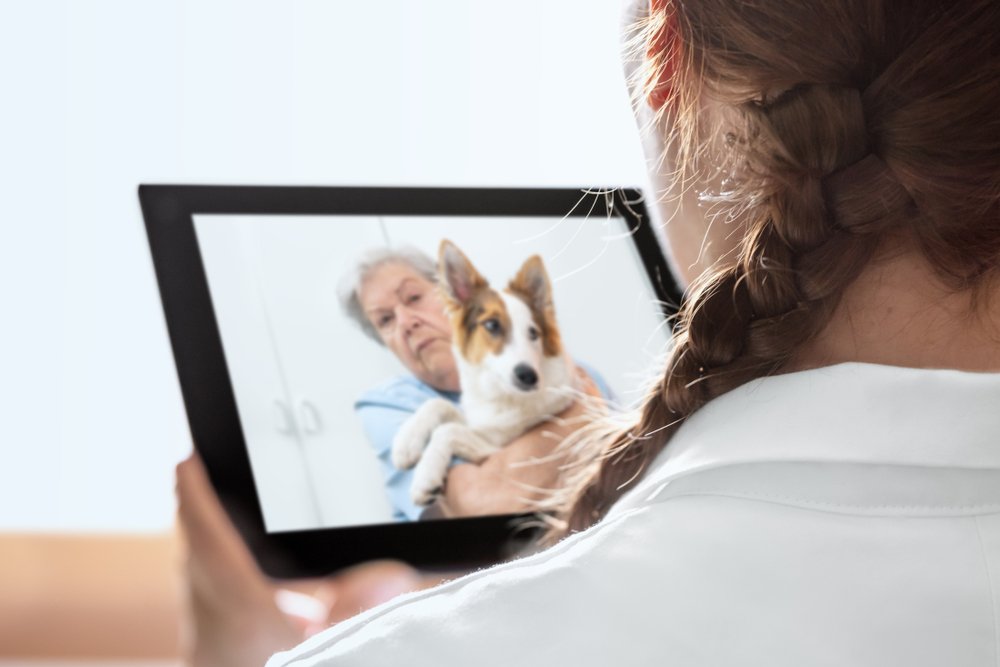The COVID-19 pandemic changed the world in many ways, both negative and positive. One of the positive things to come out of lockdowns was the expansion of virtual health care options. We can now visit nearly any member of our healthcare team from the comfort of our own home, and this extends to our furry family members, too.
Virtual veterinary care is a convenient option for pet owners looking for advice, health tips, and more. However, it can be nerve-wracking to go into your first virtual vet visit blind. That’s why we put together this guide to provide some insight into how virtual veterinary care works and what you should expect during your first “visit”. Read on to learn more.


How Does It Work?
In general terms a virtual vet visit involves contacting a veterinarian through an online platform from the comfort of your own home. Virtual vet visits operate differently depending on your provider. Some are free, others require a fee per visit, and some providers even offer a membership or subscription plan.
Your virtual visit will connect you with a licensed veterinarian remotely, whether it be through phone calls, emails, live chat, or video calls.


What Services are on Offer?
The services that are available generally fall under the following categories:
- Telemedicine requires you and your pet to have a pre-existing in person relationship with a veterinarian, they may then be able to prescribe medication and give a diagnosis (this is state and country dependent).
- Teletriage/Teleadvice is available if you have not met a veterinarian with your pet in person and therefore do not have an active Veterinarian Client Pet Relationship (VCPR). Again, depending on state regulations, it is likely that the veterinarian you contact will be able to provide general advice, opinion and education but not make diagnosis or prescribe medication.
It is important to have realistic expectations of what can be provided by a virtual vet visit and to understand that the veterinarians involved are regulated and must follow laws and regulations on the type of service they can offer you.
What Are the Different Types of Virtual Vet Visits?
As you can imagine, virtual veterinary visits are not suitable for every situation. Let’s look at a few types of appointments that would qualify.
Qualifying visits would include things like check-ups, follow-ups, and advising sessions. Virtual vets can offer general advice regarding nutrition, sterilization, surgical procedures, vaccinations, parasite prevention, and more.
They can offer teletriage services to help you determine whether your pet’s current situation is an emergency that requires immediate attention at your regular veterinary clinic or if it’s more of a “wait and see” type of situation.
However, because they’re not able to physically examine your pet, they can usually only provide their opinion on the clinical signs your pet may be exhibiting but they may be regulated not to give a diagnosis. Diagnosis of illness in most states and countries is not allowed on the basis of a virtual consultation alone.


When Is It Not Recommended to Make a Virtual Vet Visit?
A virtual vet visit is not recommended in emergency or serious illness situations. Contact your regular veterinarian or out of hours clinic in the first instance. The only variation to this is if your insurance provider states you must contact their veterinary service first, before financial assistance is given.
There are limitations to what a vet can accomplish virtually. While they can provide peace of mind and ease stress for pet owners who are concerned about their animal’s health, there are many situations where you must seek in-person veterinary care.
This can include circumstances such as:
- Trauma (road traffic accidents or fight wounds)
- Gastrointestinal issues (e.g., vomiting or diarrhea)
- Not eating for over 24 hours
- Inability to urinate
- Bleeding
- Seizures
- Paralysis
- Difficulty breathing
- Limping
- Injuries and accidents
- Eye trauma
- Difficult or prolonged labor in a pregnant pet
- Bloated abdomen
Advantages and Disadvantages of Virtual Veterinary Visits
Advantages:
- Convenience. Getting a sick pet to the vet can feel impossible to manage. And, if the pet owner has mobility issues or is sick themselves, going to the vet may very well be out of the question.
- Reduced stress. For some pets, a car ride or clinic visit can be an extremely traumatic experience. Virtual vet visits offer a convenient way to consult with a veterinarian from the comfort of your home, reducing stress on your pet. While they are more cost-effective compared to in-person visits, they may not offer a hands-on physical examination or diagnostic testing. It’s important to have a stable internet connection, a quiet area for the call, a list of questions, your pet nearby, and their medical information ready before a virtual vet visit. Medications can be prescribed during these visits, but regulations vary by location. It’s essential to understand the requirements for a vet-client-patient relationship and what services virtual vets can provide in your area. Overall, virtual vet visits can be a helpful supplement to traditional veterinary care for non-emergency situations. sentence: “She walked slowly down the path, her footsteps echoing in the quiet forest.”
As she made her way down the path, her slow footsteps reverberated through the serene forest. following sentence in a different way:
The dog happily wagged its tail as its owner returned home.
The dog’s tail wagged happily upon its owner’s return.

